Celebrating Exploration & Failure: A culture of learning, applying and repeating.
- By Sangeetha V. Karthik
- 06/01/18
Technology has effectively shrunk our globe and managed to fast forward time. The prognosis is either exciting or dire—depending on how you see it. Rapid developments in technology mean today’s students will switch careers, not jobs, five times during their lifetime.
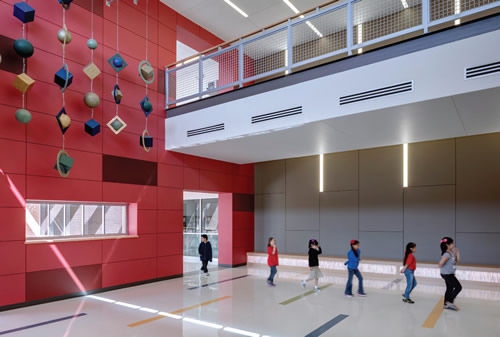
In a future filled with unknowns and variables, it is essential for students to be adaptable learners, adopt new skills with ease, apply their knowledge to problem solve, and make mindful decisions by application of critical thinking.
Fortunately, legislature measures, industry demands, and economic trends have helped make progress on public education. This has fostered a STEAM talent pipeline that highly values the arts, allows room for productive failures, and prioritizes the in-demand 21st-century skills of self-discovery, adaptability, and continuous learning.
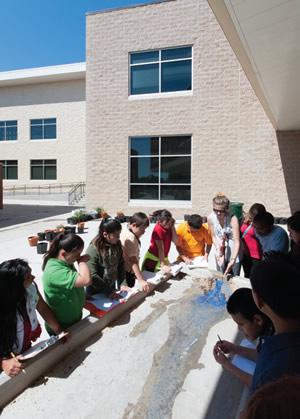 Anyone who has never made a mistake has never tried anything new. — Albert Einstein
Anyone who has never made a mistake has never tried anything new. — Albert Einstein
Casually and intentionally weaving encounters between science and art into educational environments cultivates a culture which celebrates the trials and errors of creative exploration. This is fundamental not only to STEAM education but to the jobs and global economies of the future.
CREATING MOMENTS
Accidental discoveries enrich and add confidence to the learning experience. For instance, while the concepts of erosion can be taught inside a classroom, a sand and water table in a school courtyard furnishes educators with an opportunity for the more engaging acts of learning and self-led discovery. Similarly, reading about a cultural dance in a social studies book flattens what could be a dynamic learning moment, and misses the potential for students to fully understand its movements. Experiential moments can foster student exploration in related areas. Reserving STEAM for magnet schools overlooks practical, easy opportunities to integrate its principles into the culture, space, and community of every school. Every student is encouraged to participate in athletics or play a sport, even if they don’t excel in it, with the notion that it teaches the fundamentals of teamwork and nurtures healthy habits. The same principle should be applied to the sciences and arts— encouraging participation to develop a marketable familiarity with their fundamentals and reinforcing a culture of adaptable learning in preparation for the jobs of tomorrow.
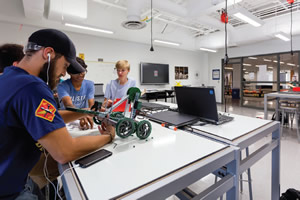 For this to work, we need to dismantle barriers and democratize the sciences and art. While educational leaders primarily shape how instruction is delivered, their role should not eclipse the important role and powerful potential of educational environments to complement curriculums and augment the experiential learning process. Teaching tools, spaces and buildings reinforce the pedagogies, presenting designers with the continued challenge of creating moments that resonate with students and pique their curiosity every day. When the emphasis is on the joy of discovery, whether it is how native plants adapt or how colors in an art piece invokes emotion, content is mastered in the process. The life cycle of the butterfly is better understood in a greenhouse and research shows visual and performing arts programs keeps students in school.
For this to work, we need to dismantle barriers and democratize the sciences and art. While educational leaders primarily shape how instruction is delivered, their role should not eclipse the important role and powerful potential of educational environments to complement curriculums and augment the experiential learning process. Teaching tools, spaces and buildings reinforce the pedagogies, presenting designers with the continued challenge of creating moments that resonate with students and pique their curiosity every day. When the emphasis is on the joy of discovery, whether it is how native plants adapt or how colors in an art piece invokes emotion, content is mastered in the process. The life cycle of the butterfly is better understood in a greenhouse and research shows visual and performing arts programs keeps students in school.
HANDS ON LEARNING
With the advent of collaboration spaces in schools today, we teach students the importance and power of collective knowledge—the idea that perspectives can be shared, challenged, evaluated and effectively implemented or tabled based on their merit. When students understand that they have the power to create and innovate to change the world, the STEAM fields become more relevant, more attractive, and more tangibly meaningful.
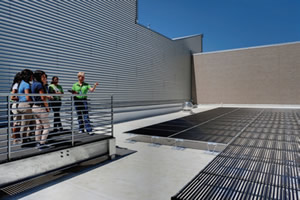 Such hands-on and empowered learning requires a personalized, comfortable, flexible and readily accessible environment. Intentional design seeks to provide opportunities to apply concepts taught in a classroom. In a Health Science setting, based on industry expert input, it was determined that one of the skills difficult to master is the transfer of responsibility. The program spaces were positioned to allow students to practice transfers from the EMT to Nursing students.
Such hands-on and empowered learning requires a personalized, comfortable, flexible and readily accessible environment. Intentional design seeks to provide opportunities to apply concepts taught in a classroom. In a Health Science setting, based on industry expert input, it was determined that one of the skills difficult to master is the transfer of responsibility. The program spaces were positioned to allow students to practice transfers from the EMT to Nursing students.
Imagine bringing to life a lesson plan on sustainable energy. For example, by collecting and analyzing data from solar panels at their own school to understand building energy use in relation to energy production, they can apply their findings to influence the behaviors of the student body.
A CULTURE OF RESEARCH
The evolution of education demands learning environments be fertile ground for knowledge and a place to build a community that explores and shares ideas. Libraries are being reinvented as dynamic media centers or flexible maker spaces with 3D printers and robotic kits. These interactive, transformed spaces are extended learning hubs for curriculum delivery, research and application of concepts.
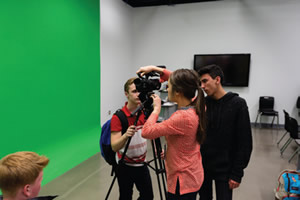 Tapping into unexpected occasions for learning and collaboration, the built environment can boost a culture of research and celebrate the quest for knowledge by offering diverse spaces for learning. Indoors and outdoors, casual and intentional, large and intimate, individual “heads down” spaces and collaboration zones are equally important. The idea that learning can happen anywhere within a campus, reinforced by the access to technology, flexible furnishings and visual connectivity, places learning on display, increases accessibility to ideas and encourages hands-on exploration and collaboration.
Tapping into unexpected occasions for learning and collaboration, the built environment can boost a culture of research and celebrate the quest for knowledge by offering diverse spaces for learning. Indoors and outdoors, casual and intentional, large and intimate, individual “heads down” spaces and collaboration zones are equally important. The idea that learning can happen anywhere within a campus, reinforced by the access to technology, flexible furnishings and visual connectivity, places learning on display, increases accessibility to ideas and encourages hands-on exploration and collaboration.
The intersection of the STEAM fields in every discipline today is a clue to what the future holds. Making STEAM education accessible and inspiring is crucial for success at a personal and global level. When students are exposed to a pedagogy that values a culture of research and experimentation, STEAM fields are the next logical step in their education.
This article originally appeared in the School Planning & Management June 2018 issue of Spaces4Learning.
About the Author
Sangeetha Karthik, AIA, LEED AP B+C, is a vice president at Corgan. She may be contacted at [email protected].